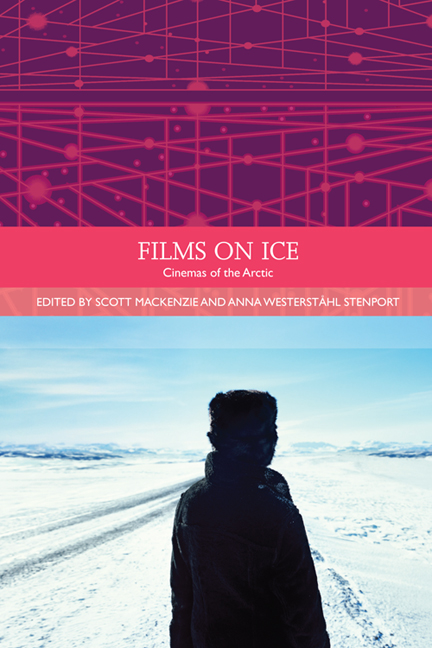Book contents
- Frontmatter
- Contents
- List of Illustrations
- Acknowledgements
- Traditions in World Cinema
- Introduction: What are Arctic Cinemas?
- PART I GLOBAL INDIGENEITY
- PART II HOLLYWOOD HEGEMONY
- PART III ETHNOGRAPHY AND THE DOCUMENTARY DILEMMA
- PART IV MYTHS AND MODES OF EXPLORATION
- 20 The Changing Polar Films: Silent Films from Arctic Exploration 1900–30
- 21 The Attractions of the North: Early Film Expeditions to the Exotic Snowscape
- 22 Frozen in Motion: Ethnographic Representation in Donald B. MacMillan's Arctic Films
- 23 ‘My Heart Beat for the Wilderness’: Isobel Wylie Hutchison, Jenny Gilbertson, Margaret Tait and Other Twentieth-Century Scottish Women Filmmakers
- 24 ‘Here will be a Garden-City’: Soviet Man on an Arctic Construction Site
- 25 Transcending the Sublime: Arctic Creolisation in the Works of Isaac Julien and John Akomfrah
- 26 DJ Spooky and Dziga Vertov: Experimental Cinema Meets Digital Art in Exploring the Polar Regions
- Notes on the Contributors
- Index
21 - The Attractions of the North: Early Film Expeditions to the Exotic Snowscape
from PART IV - MYTHS AND MODES OF EXPLORATION
Published online by Cambridge University Press: 05 September 2016
- Frontmatter
- Contents
- List of Illustrations
- Acknowledgements
- Traditions in World Cinema
- Introduction: What are Arctic Cinemas?
- PART I GLOBAL INDIGENEITY
- PART II HOLLYWOOD HEGEMONY
- PART III ETHNOGRAPHY AND THE DOCUMENTARY DILEMMA
- PART IV MYTHS AND MODES OF EXPLORATION
- 20 The Changing Polar Films: Silent Films from Arctic Exploration 1900–30
- 21 The Attractions of the North: Early Film Expeditions to the Exotic Snowscape
- 22 Frozen in Motion: Ethnographic Representation in Donald B. MacMillan's Arctic Films
- 23 ‘My Heart Beat for the Wilderness’: Isobel Wylie Hutchison, Jenny Gilbertson, Margaret Tait and Other Twentieth-Century Scottish Women Filmmakers
- 24 ‘Here will be a Garden-City’: Soviet Man on an Arctic Construction Site
- 25 Transcending the Sublime: Arctic Creolisation in the Works of Isaac Julien and John Akomfrah
- 26 DJ Spooky and Dziga Vertov: Experimental Cinema Meets Digital Art in Exploring the Polar Regions
- Notes on the Contributors
- Index
Summary
Since the emergence of moving pictures, putting the exotic (in all its diversity) on display has been a recurrent feature of film exhibition. Educating audiences about faraway places and customs, and the attraction of experiencing localities and regional customs via moving pictures were prime reasons for the medium's immediate impact. This is clear to a reviewer of the 1914 feature film Högfjällets dotter (Daughter of the Peaks, Sweden) about a young Sámi woman in Northern Sweden, directed by Victor Sjostrom: ‘Notwithstanding the multitude of misgivings the enemies of cinema might level against the very existence of film theatres, they cannot deny the importance of films for disseminating knowledge about different regions around world’ (Svenska Dagbladet 1914).
Before the global spread of domestic film production, the depiction of many regions and minority populations in the world was dependent on French, British and American companies. This is the case also in Northernmost Europe, where international but also Swedish film companies made travelogues from the North into a small, but quite discernible genre of early filmmaking that often mixed fiction and non-fiction storytelling.
‘Actualit és’ featuring local and distant scenes were prominent in the very first film programmes offered by the Lumi ère brothers in 1896. Such representations would dominate their catalogue until the company abandoned film production in 1905 (see Aubert and Seguin 1996). When ‘le cin ématographe’ was introduced in a new country – which occurred in rapid succession after the famous screening at the Grand Caf é in Paris in December 1895 – Lumi ère cameramen arrived with the equipment (a camera and projector in one) to supervise the film exhibition. In addition, they captured new scenes locally. These scenes would be included in the local programme and later added to the overall Lumi ère repertoire. In terms of exhibition, the company's world tours thus mixed local images with those from far-off countries. This was a successful production model and programming strategy, outlasting the Lumi ères (see Snickars 2001; Dahlquist 2005). Local vistas and scenery, and even familiar faces, offered a welcome contrast to films exploring fantasies about intangible foreign lands, peoples and cultural practices.
- Type
- Chapter
- Information
- Films on IceCinemas of the Arctic, pp. 279 - 285Publisher: Edinburgh University PressPrint publication year: 2014



